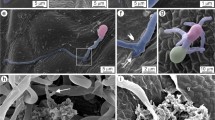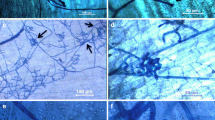Abstract
Gilbertella persicaria is a pathogenic fungus recently reported as a causative agent of soft rot in papaya fruits. Here the interactions between G. persicaria and papaya fruits was analyzed under laboratory conditions using histological techniques and optical microscopy to elucidate the process of pathogenesis. Healthy and disinfested fruits of papaya cv. Maradol were also inoculated with a suspension of sporangiospores of G. persicaria. Tissue sections were cut, which were subjected to differential staining with safranin-fast green for different times. Sporangiospores presumably adhered to the cuticle of the fruit by 3 h post inoculation (hpi) and germinated by 6 hpi; invasive intracellular hyphae were growing in host cells by 9 hpi. By 15 hpi, fruit epidermis was macerated, presumably by enzymatic activity reported for mucoral fungal species and appeared as a wet-looking lesion on the cuticle. Fruit mesocarp was colonized by 30 hpi, and asexual reproduction structures had formed by 48 hpi. This process of infection and disease development of G. persicaria in papaya fruits corresponds to that used by pathogens with a necrotrophic lifestyle.



Similar content being viewed by others
References
Cruz-Lachica I, Márquez-Zequera I, García-Estrada RS, Carrillo-Fasio JA, León-Félix J, Allende-Molar R (2017) Identification of mucoralean fungi causing soft rot in papaya (Carica papaya L.) fruit in Mexico. Mex J Phytopathol 35:397–417
Ginting C, Zehr EI, Westcott SW (1996) Inoculum sources and characterization of isolates of Gilbertella persicaria from peach fruit in South Carolina. Plant Dis 80:1129–1134
Guo LW, Wu XY, Mao ZC, Ho HH, He YQ (2012) Storage rot of dragon fruit caused by Gilbertella persicaria. Plant Dis 96:1826
Hesseltine CW (1960) Gilbertella gen. nov. (Mucorales). Bull Torrey Bot Club 87:21–30
Horbach R, Navarro-Quesada AR, Knogge W, Deising HB (2011) When and how to kill a plant cell: infection strategies of plant pathogenic fungi. J Plant Physiol 168:51–62
Kubicek CP, Starr TL, Glass NL (2014) Plant cell wall-degrading enzymes and their secretion in plant-pathogenic fungi. Annu Rev Phytopathol 52:427–451
Lo Presti L, Lanver D, Schweizer G, Tanaka S, Liang L, Tollot M, Zuccaro A, Reissmann S, Kahmann R (2015) Fungal effectors and plant susceptibility. Annu Rev Plant Biol 66:513–545
Mehrotra MD (1963) Fruit rot of tomato caused by Gilbertella persicaria. Sydowia 17:17–19
Pinho DB, Pereira OL, Soares DJ (2014) First report of Gilbertella persicaria as the cause of soft rot of fruit of Syzygium cumini. Aust Plant Dis Notes 9:143–146
Rodríguez-López ES, Cárdenas-Soriano E, Hernández-Delgado S, Gutiérrez-Diez A, Mayek-Pérez N (2013) Analysis of Colletotrichum gloeosporioides (Penz.) Penz. & Sacc. infection of avocado fruits (in Spanish with English summary). Rev Bras Frutic 35:898–905
Rojo-Báez I, García-Estrada RS, Sañudo-Barajas JA, León-Félix J, Allende-Molar R (2017) Infection process of anthracnose by Colletotrichum truncatum on papaya Maradol (in Spanish with English summary). Rev Bras Frutic 39:e-379
Struck C (2006) Infection strategies of plant parasitic fungi. In: Cooke BM, Kaye B, Jones DG (eds) The epidemiology of plant diseases. Springer, Dordrecht, Netherlands, pp 117–131
Takó M, Lung S, Krisch J, Papp T, Vágvölgyi C (2009) Production of cellulolytic enzymes on agricultural waste by different zygomycetes. Ann Fac Eng Hunedoara 4:169–172
Takó M, Farkas E, Lung S, Krisch J, Vágvölgyi C, Papp T (2010) Identification of acid- and thermotolerant extracellular β-glucosidase activities in zygomycetes fungi. Acta Biol Hung 61:101–110
Vieira JCB, Câmara MPS, Bezerra JDP, Motta CMS, Machado AR (2018) First report of Gilbertella persicaria causing soft rot in eggplant fruit in Brazil. Plant Dis 102:1172. https://doi.org/10.1094/PDIS-09-17-1379-PDN
Yeung EC (1999) The use of histology in the study of plant tissue culture systems—some practical comments. In Vitro Cell Dev Biol Plant 35:137–143
Author information
Authors and Affiliations
Corresponding author
Ethics declarations
Ethical standards
This article does not contain any studies with human participants or animals.
Conflict of interest
The authors declare that they have no conflict of interest.
Rights and permissions
About this article
Cite this article
Cruz-Lachica, I., Marquez-Zequera, I., Allende-Molar, R. et al. Infection process of Gilbertella persicaria in papaya (Carica papaya L.) fruits. J Gen Plant Pathol 84, 339–342 (2018). https://doi.org/10.1007/s10327-018-0798-z
Received:
Accepted:
Published:
Issue Date:
DOI: https://doi.org/10.1007/s10327-018-0798-z




